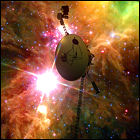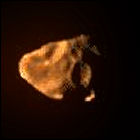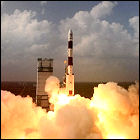 Launched in August 1977 prior to the departure of its sister ship, Voyager 1, NASA’s Voyager 2 space probe exits the heliosphere, the region where the solar wind from Earth’s sun has more influence than the interstellar medium between stars. Unlike Voyager 1, Voyager 2’s plasma science instruments are still working, so the instrument readings indicating a dramatic change in local space are very clear to the vehicle’s ground controllers (Voyager 1’s exit from the heliosphere in 2012 had been much more ambiguous at first). At over eleven billion miles from the Earth, radio signals take more than 16.5 hours to reach or be received from Voyager 2 at the time of its entry into the interstellar medium, and it is expected to return science data through the 2020s. It will pass within two years of the star Ross 248 in 40,000 years.
Launched in August 1977 prior to the departure of its sister ship, Voyager 1, NASA’s Voyager 2 space probe exits the heliosphere, the region where the solar wind from Earth’s sun has more influence than the interstellar medium between stars. Unlike Voyager 1, Voyager 2’s plasma science instruments are still working, so the instrument readings indicating a dramatic change in local space are very clear to the vehicle’s ground controllers (Voyager 1’s exit from the heliosphere in 2012 had been much more ambiguous at first). At over eleven billion miles from the Earth, radio signals take more than 16.5 hours to reach or be received from Voyager 2 at the time of its entry into the interstellar medium, and it is expected to return science data through the 2020s. It will pass within two years of the star Ross 248 in 40,000 years.
 The 128th episode of Joss Whedon’s supernatural series Buffy The Vampire Slayer, starring Sarah Michelle Gellar, airs on UPN. James Marsters and Alyson Hannigan also star.
The 128th episode of Joss Whedon’s supernatural series Buffy The Vampire Slayer, starring Sarah Michelle Gellar, airs on UPN. James Marsters and Alyson Hannigan also star.
 Nearing the end of its fuel supply, NASA’s Galileo probe passes one of Jupiter’s innermost moons, tiny, asteroid-like Amalthea, at a distance of less than 100 miles, coming closer to Jupiter and its belts of intense radiation than ever before. This final flyby of a Jovian moon is a punishing one for Galileo: the failure of Galileo’s main antenna dish after its 1989 launch has forced the robotic explorer to store its findings on tape for later playback to Earth at a low bit rate, but in this case roughly half of Galileo’s measurements of the highly charged environment near Jupiter are lost to radiation-induced failure of the tape recording system. The intense radiation also causes enough faults in Galileo’s main computer that the probe puts itself in a failsafe mode and “sleeps” until further commands are received from Earth hours later.
Nearing the end of its fuel supply, NASA’s Galileo probe passes one of Jupiter’s innermost moons, tiny, asteroid-like Amalthea, at a distance of less than 100 miles, coming closer to Jupiter and its belts of intense radiation than ever before. This final flyby of a Jovian moon is a punishing one for Galileo: the failure of Galileo’s main antenna dish after its 1989 launch has forced the robotic explorer to store its findings on tape for later playback to Earth at a low bit rate, but in this case roughly half of Galileo’s measurements of the highly charged environment near Jupiter are lost to radiation-induced failure of the tape recording system. The intense radiation also causes enough faults in Galileo’s main computer that the probe puts itself in a failsafe mode and “sleeps” until further commands are received from Earth hours later. The soundtrack from
The soundtrack from  BBC3 premieres the
BBC3 premieres the  Silva Screen Records releases a CD of Murray Gold’s soundtrack music from the
Silva Screen Records releases a CD of Murray Gold’s soundtrack music from the  The
The  India launches its first deep space unmanned mission, sending the Mangalayaan probe toward the planet Mars. Using the proven Polar Satellite launcher, India’s entry into the field of interplanetary exploration runs up a bill equivalent to only $70,000,000. Mangalayaan – known to much of the rest of the world as MOM (Mars Orbiter Mission) – is designed to survey the Martian atmosphere and examine the planet’s surface from orbit. It will arrive at Mars ten months later.
India launches its first deep space unmanned mission, sending the Mangalayaan probe toward the planet Mars. Using the proven Polar Satellite launcher, India’s entry into the field of interplanetary exploration runs up a bill equivalent to only $70,000,000. Mangalayaan – known to much of the rest of the world as MOM (Mars Orbiter Mission) – is designed to survey the Martian atmosphere and examine the planet’s surface from orbit. It will arrive at Mars ten months later. The 51st episode of Arrow, a modern-day reboot of DC Comics’ Green Arrow superhero starring Stephen Amell, airs on the CW. Brandon Routh (Superman Returns) guest stars.
The 51st episode of Arrow, a modern-day reboot of DC Comics’ Green Arrow superhero starring Stephen Amell, airs on the CW. Brandon Routh (Superman Returns) guest stars. Cable channel Disney XD airs the
Cable channel Disney XD airs the  Streaming service CBS All Access releases
Streaming service CBS All Access releases  The CW airs the 54th episode of Legends Of Tomorrow, starring Caity Lotz, Matt Ryan, Brandon Routh, and Tala Ashe. Anjli Mohindra (The Sarah Jane Adventures) guest stars.
The CW airs the 54th episode of Legends Of Tomorrow, starring Caity Lotz, Matt Ryan, Brandon Routh, and Tala Ashe. Anjli Mohindra (The Sarah Jane Adventures) guest stars. Launched in August 1977 prior to the departure of its sister ship, Voyager 1, NASA’s Voyager 2 space probe exits the heliosphere, the region where the solar wind from Earth’s sun has more influence than the interstellar medium between stars. Unlike Voyager 1, Voyager 2’s plasma science instruments are still working, so the instrument readings indicating a dramatic change in local space are very clear to the vehicle’s ground controllers (Voyager 1’s exit from the heliosphere in 2012 had been much more ambiguous at first). At over eleven billion miles from the Earth, radio signals take more than 16.5 hours to reach or be received from Voyager 2 at the time of its entry into the interstellar medium, and it is expected to return science data through the 2020s. It will pass within two years of the star Ross 248 in 40,000 years.
Launched in August 1977 prior to the departure of its sister ship, Voyager 1, NASA’s Voyager 2 space probe exits the heliosphere, the region where the solar wind from Earth’s sun has more influence than the interstellar medium between stars. Unlike Voyager 1, Voyager 2’s plasma science instruments are still working, so the instrument readings indicating a dramatic change in local space are very clear to the vehicle’s ground controllers (Voyager 1’s exit from the heliosphere in 2012 had been much more ambiguous at first). At over eleven billion miles from the Earth, radio signals take more than 16.5 hours to reach or be received from Voyager 2 at the time of its entry into the interstellar medium, and it is expected to return science data through the 2020s. It will pass within two years of the star Ross 248 in 40,000 years. The CW airs the 118th episode of The Flash, a modern-day reboot of DC Comics’ superhero starring Grant Gustin. Sendhil Ramamurthy (Heroes) and Danny Trejo guest star.
The CW airs the 118th episode of The Flash, a modern-day reboot of DC Comics’ superhero starring Grant Gustin. Sendhil Ramamurthy (Heroes) and Danny Trejo guest star.